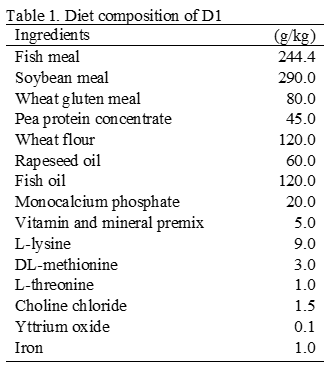BIOCHAR AS A PROMISING FEED ADDITIVE IN DIETS FOR ATLANTIC SALMON PRE-SMOLTS
Introduction
The use of biochar as a feed additive has gained increasing attention in animal nutrition due to its potential benefits on digestion, nutrient absorption, and overall health. Biochar, a carbon-rich product derived from pyrolysis of organic materials, has been traditionally used in animal husbandry for toxin adsorption and digestive health enhancement, but recent studies have highlighted its broader applications, including improvements in feed efficiency, reduction of greenhouse gas emissions, and enhancement of animal welfare (Schmidt et al., 2019). However, the systematic evaluation of biochar’s effects on aquaculture species, particularly Atlantic salmon, remains limited.
Experimental set-up
A basal commercial-like diet (D1) was formulated to meet or exceed the nutritional requirements of Atlantic salmon according to NRC (2011), without any additional growth-promoting ingredients (Table 1). Biochar, either 0.25% (D2) or 0.50% (D3), was added to the basal diet. The biochar was provided by OBIO (Norway) and was ground to 1mm.
The diets were produced by extrusion at Fôrtek (Center for Feed Technology, NMBU, Aas, Norway), with a 2mm die and with a final diameter of ca. 2.4mm. After drying until 8-10% moisture, pellets were vacuum coated with fish oil and rapeseed oil.
A four-week experiment was conducted at the Center for Fish Trials (NMBU, Aas, Norway). A total of 315 pre-smolts Atlantic salmon with an initial average body weight of 31.7 g were randomly distributed into nine 300L fiberglass tanks (35 fish per tank). Fish received one of the three diets, ad libitum, with three replicate tanks per diet. Each tank had a capacity of 300 L. Uneaten feed was collected daily to calculate feed intake according to Helland et al. (1996).
Results and Discussion
Physical pellet quality: The inclusion of biochar in diets for Atlantic salmon significantly affected the physical pellet quality. Pellets from diets D2 and D3 were harder (p = 0.001) and had slower sinking velocity (p = 0.012) compared to D1 pellets, which allowed the pellets to stay in the water column longer, providing more time for the fish to feed and thereby reducing feed waste. In addition, diet D3 had a significantly higher water stability index (p = 0.039), which is a desired characteristic for fish production in RAS systems.
Lastly, in accordance with the previous results, there was a lower waste output in fish fed diets containing biochar (Figure 1). There was a strong tendency for reduced total solid waste (p = 0.065) and a significant reduction in solid nitrogen waste (p = 0.015), suggesting that biochar improves nutrient utilization, potentially reducing nitrogen excretion. Overall, results suggest that the use of biochar in RAS systems can reduce solid wastes, reduce maintenance costs, and minimize environmental impact.
Growth performance: No significant differences were observed in the growth performance parameters such as specific growth rate (SGR), feed conversion ratio (FCR) and final body weight. However, there was a numerical increase in weight gain and specific growth rate (SGR) and a numerical decrease in FCR for fish fed diets D2 and D3 compared to D1.
Digestibility: The apparent digestibility coefficients of dry matter, crude protein, ash, and carbon increased significantly in fish fed diets D2 and D3 (Table 2). This improved digestibility suggests a better nutrient utilization when Atlantic salmon diets are supplemented with biochar.
Intestinal health and metabolism: Histological analysis of 12 fish/diet revealed that the inclusion of biochar did not have any effect on mucosal structure. No significant differences in enteritis or mucosal atrophy were observed. Analysis of plasma revealed no differences between dietary groups regarding their enzyme activity (e.g., ALP, AST, DGGR), metabolites (e.g., albumin, bile acid, glucose, cholesterol), vitamins (A, D and E) or minerals (K, Ca, Na, P). Biochar is commonly associated with a high absorption capacity and there was the possibility of some nutrients being retained by the biochar and not absorbed by the fish. The current results suggest that biochar did not impact intestinal structure nor plasmatic levels of metabolism-related compounds.
Microbiota: 16S rRNA sequencing in distal intestine digesta is currently being carried out to determine the effect of biochar in intestinal microbiota, as has been reported in other studies.
Conclusion
The current results suggest that biochar has potential as a sustainable feed additive in RAS aquaculture. Inclusion of biochar in diets not only reduced solid waste production, potentially improving system efficiency, but also resulted in improved nutrient utilization and had no adverse effects on fish health.
References
Helland, S.J., et al. (1996). A simple method for the measurement of daily feed intake of groups of fish in tanks. Aquaculture. https://doi.org/10.1016/0044-8486(95)01145-5
NRC (2011). Nutrient requirements of fish and shrimp. National academies press.
Schmidt, et al. (2019). The use of biochar in animal feeding. PeerJ. https://doi.org/10.7717/peerj.7373

